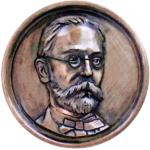Current issue
Online first
Special issues
Archive
About the Journal
Editorial Board
Editorial Council
Reviewers
Editorial guidelines
Publication ethics
Guidelines for reviewing
Remarks on “ghostwriting”
Copyrights and Open Access rule
GDPR Privacy Notice – for the authors of articles sent for publication in the "Komunikaty Mazursko-Warmińskie ("Masuro-Warmian Bulletin")
Contact
Price list
About the essense of the masurian Gromadkar movement
Online publication date: 2019-07-20
Publication date: 2019-07-20
KMW 2019;304(2):218-242
KEYWORDS
Gromadkar movementPietismmembers of the Fellowship MovementMasuriansLutheran theology19th centuryEast PrussiaChristopherKukat
TOPICS
ABSTRACT
After the Reformation Masurians as subjects of the rulers of the first evangelical state in the world became
Lutherans. Over time, the inhabitants of the southern areas of Easy Prussia and the so- called Lithuania Minor
felt the lack of the deepened spirituality, which they did not find in the evangelical church. Through the settled
in Gąbin (Gumbinnen) exiled from the area of Salzburg pietist Evangelists in Masuria, “The six books on True
Christianity” by John Arndt appeared. The book, after the Bible and the Small Catechism of Luther became the
most popular among people of Masuria. The first piety movements appeared in Masuria in the county of Nidzica
and Szczytno at the turn of the 18th and 19th centuries. However their true upturn took place from the 1840s. It
manifested itself in running home services, prayer meetings- so-called “beads” and increased activity of travelling
preachers. In the seventies and eighties of the nineteenth century, The Gromadkar movement comprised between
30 and 80% of the Masurian population. The centre of the Masurian clusters was located near Szczytno, Pisz and
Mrągowo. Registered in 1885 by the Prussian Lithuanian Christopher Kukat , the East Prussian Evangelical Prayers
Association which with the help of its bilingual (German Lithuanian) paper Pakajaus Paslas/ Friedens- Bote gave
the organizational framework to the East Prussian clusters. At the turn of 19th and 20th centuries, the Gromadkar
movement reached its apogee, also spreading among the Mazurian workers’ communities in the Ruhr. Since the
First World War, there has been a gradual stifling of the movement, which in the Nazi era entered agonal phase.
The key to understanding the world of clusters is the “Six Books on True Christianity” by John Arndt, in which he
creates a kind of bridge between Luther’s teachings and the writings of the Rhine mystics of Master Eckhart, John
Tauler and Henry Suzo, giving Mazurians directions for spiritual growth. It was supposed to rely on “Six Books”
to deny yourself, to reject your own ego, to seek contact with God, indicating as the goal the union with God.
The uniqueness of the Gromadkar movement consisted in going beyond the Lutheran principle of “justification
by faith” and entering the ground of Christian mysticism unknown to the Evangelical doctrine, which happened
through the work of Arndt. An additional aspect that opens up in this context is the Slavic and Lithuanian spirituality and the sensitivity of the crowd, without which undoubtedly it would not be possible to practice mysticism
on the basis of the Evangelical religion.
Share
RELATED ARTICLE
We process personal data collected when visiting the website. The function of obtaining information about users and their behavior is carried out by voluntarily entered information in forms and saving cookies in end devices. Data, including cookies, are used to provide services, improve the user experience and to analyze the traffic in accordance with the Privacy policy. Data are also collected and processed by Google Analytics tool (more).
You can change cookies settings in your browser. Restricted use of cookies in the browser configuration may affect some functionalities of the website.
You can change cookies settings in your browser. Restricted use of cookies in the browser configuration may affect some functionalities of the website.




